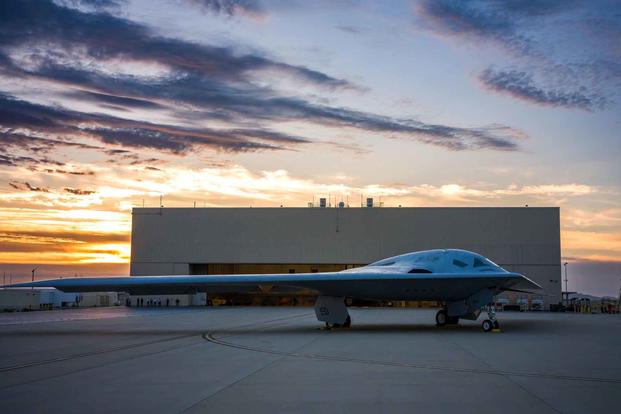The Air Force's new highly classified nuclear-capable stealth bomber, the B-21 Raider, made its first flight Friday morning, nearly one year after the multimillion-dollar aircraft was revealed to the public and as global tensions in the Pacific and Middle East continue to grow.
Images and videos of a B-21 taxiing on the runway of the Air Force's Plant 42 in Palmdale, California, and later taking to the skies began circulating online early Friday morning. Ann Stefanek, an Air Force spokeswoman, confirmed to Military.com that the B-21 has begun flight testing.
"Flight testing is a critical step in the test campaign managed by the Air Force Test Center and 412th Test Wing's B-21 Combined Test Force to provide survivable, long-range, penetrating strike capabilities to deter aggression and strategic attacks against the United States, allies and partners," Stefanek said. "Flight testing includes ground testing, taxiing and flying operations."
Read Next: As America Celebrates Its Veterans, the Population Is Younger, More Diverse and Shrinking
Videos show the B-21 Raider slowly whooshing over Palmdale. The flight was not publicized by the Air Force, and freelance and aviation photographers were among the first to see it take off. The bomber was unveiled to the public in December 2022.
The Northrop Grumman-developed B-21 is capable of carrying conventional bombs and missiles, as well as nuclear munitions. It will play a significant role in modernizing America's nuclear triad -- the combination of aircraft, land-based missiles and submarines that can deliver a nuclear payload. The defense manufacturer was awarded the contract for the aircraft in 2015.
Northrop also makes the B-2 Spirit, the previous generation of bomber, which bears more than a passing resemblance to the B-21. That aircraft, which first flew in the 1980s, has been a backbone of U.S. force projection for decades. It was one of the first major aircraft designed as a "flying wing" that didn't have a tail, an approach that gained prominence during World War II with aircraft developed for Germany by the Horten brothers.
The B-21 was named for the U.S. Army Air Force's Doolittle Raiders, whose surprise attack against Japan during World War II boosted American morale.
Many of the details of the B-21, such as its size, payload and technology, have not been made public.
But according to an Air Force fact sheet, the B-21 was "designed to accommodate manned or unmanned operations," a reflection of the increasing reliance on unmanned aircraft by the U.S. military and the future of the pilot specialty.
The Pentagon currently plans to build 100 B-21s. The average unit cost for each bomber is around $700 million, according to the fact sheet.
Historically, aircraft purchasing estimates tend to be high, with tight budgets eventually forcing the services to cut order expectations. Budget documents show that producing the Raider program will cost around $20 billion through 2027, Military.com previously reported.
Numerous Air Force bases will have a hand in the B-21's mission.
Following extensive environmental studies, in 2021, Ellsworth Air Force Base near Rapid City, South Dakota, was selected as the first installation to receive the aircraft. It will serve as the main operating base and B-21 formal training unit.
Whiteman Air Force Base in Missouri and Dyess Air Force Base in Texas will receive the aircraft as they're built, pending environmental studies. Tinker Air Force Base, Oklahoma, will oversee maintenance of the B-21, and Edwards Air Force Base, California, will lead the testing and evaluation of the bomber, according to the Air Force.
“Six test aircraft are being produced now," Stefanek said. "The test aircraft are being built on the same production line, using the same tools, processes and technicians that will build the production aircraft."
-- Thomas Novelly can be reached at thomas.novelly@military.com. Follow him on Twitter @TomNovelly.
Related: The Air Force Reveals New B-21 Bomber, Keeping the Pilot for Now










